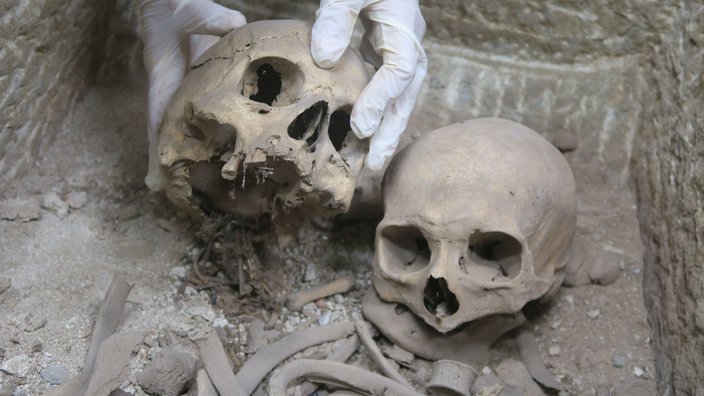Tradition reports that the four sarcophagi exhibited for more than six centuries under a fire outside the Saint-Sernin basilica housed the remains of the Counts of Toulouse. This memory, the archaeologists of the regional service of Archeology intend to verify it. As part of a preventive excavation, scientists have been inspecting since April the two side burials that surrounded the main sarcophagus of the niche, already examined in 1989. Opened last month, the two tanks studied within the heritage restoration service of Toulouse are starting to deliver their very first secrets, drop by drop. And the least we can say is that the fire located on the south transept of the church probably did not only have counts.
Read also: An Ottonian fresco from Augsburg Cathedral dating from the year 1000
Of the two sarcophagi moved out of their niche in 2019 and entrusted to scientists from the heritage restoration service, no less than 9 individuals, including a child of around ten, were counted.
Occupied by 7 of the 9 identified dead, not counting animal bones, the second open sarcophagus contained choice remains for researchers, including a few fragments of leather and a 17th century coin.
"It's a great discovery
,"
paleoanthropologist Elsa Ciesielski
told
La Dépêche
.
After restoration, she will be able to inform us about the conditions in which the sarcophagus was located. ”
Despite their very disturbed character, these burials could contain at least a few counts of Toulouse, archaeologists believe.
Among the encouraging clues, one of the lids announces very clearly, in Latin:
"Here lies Poncius, count of Toulouse"
.
The contents of the less populated sarcophagus, which houses two individuals, also seem more orderly: little - if at all - bothered in recent centuries, it possibly accommodates its original custodians.
One of the two sarcophagi before it opened.
Toulouse Town Hall
Well aware of the turbulent history of these sarcophagi, to say the least, Toulouse archaeologists were in any case little surprised by all the joyous bazaar housed in these ancient vats. Built from 1080 and consecrated by Pope Urban II in 1096, the Saint Sernin basilica has housed since the Middle Ages four sarcophagi - the two lateral ones currently being studied, the main one excavated in 1989, and a small
"children's sarcophagus"
- in inside a fire that faced a
"cemetery of the counts" which has
now disappeared. Emptied during the 18th-19th centuries, this old cemetery is undoubtedly the original burial place of some of the remains today preserved in the count's graves.
"We took the bones, and we placed them in different places, including inside these sarcophagi"
, recalled about this chaotic time the archaeologist and curator at the regional service of architecture Bastien Lefebvre, interviewed by the Toulouse daily.
Read also: Discovered in Arras, the rare sarcophagus of the Late Roman Empire reveals its first secrets
Two more years of study
Will we know more about the identity of all these occupants, left over for centuries to bad weather and pollution in the shadow of the basilica?
“It is still too early to know who the individuals found in these sarcophagi are. The answers will come soon ”
, tempers Bastien Lefebvre.
"All the bones will be sides in three dimensions, taken and studied in the laboratory
," also said in April Pierre Pisani, director of heritage at Toulouse Métropole.
There will be a major scientific publication in which we will synthesize the results of the discoveries in these two sarcophagi, and we will associate the third sarcophagus excavated in 1989 to compare and see if there are any links of kinship between the three deceased. . "
So many steps that there is no point in hurrying and which we should not see the end of anytime soon, the time to go through all the material collected with a fine comb and to carry out the various analyzes that will not fail. not to impose.
"We would like, within two years, to have a complete study on the bones and on the interpretation, on the history of the sarcophagi in relation to historical knowledge"
, summarized Bastien Lefebvre for France 3.
Read also: A large drakkar, burial place of a Viking lord, discovered in Norway
When it opened in 1989, the main sarcophagus of the fire, the most massive, did not contain, as expected, the remains of Count William III of Toulouse (c. 975-1037), said Taillefer. The anonymous remains of the
"count of the year 1000"
preserved between the solid walls of the tank was in fact about forty years old, and not about sixty as William III should be when he died. The very high quality of his clothing, à la franque, and of his funeral toilet, as well as his dating to the middle of the 10th century, has allowed researchers to conclude that he was at least an important aristocratic, probably a count. who preceded Guillaume Taillefer, perhaps Raymond V. While the actual excavation of the two neighboring sarcophagi is coming to an end, the investigation of the neighboring burial grounds of the
“count of the year 1000”.
just starting.

